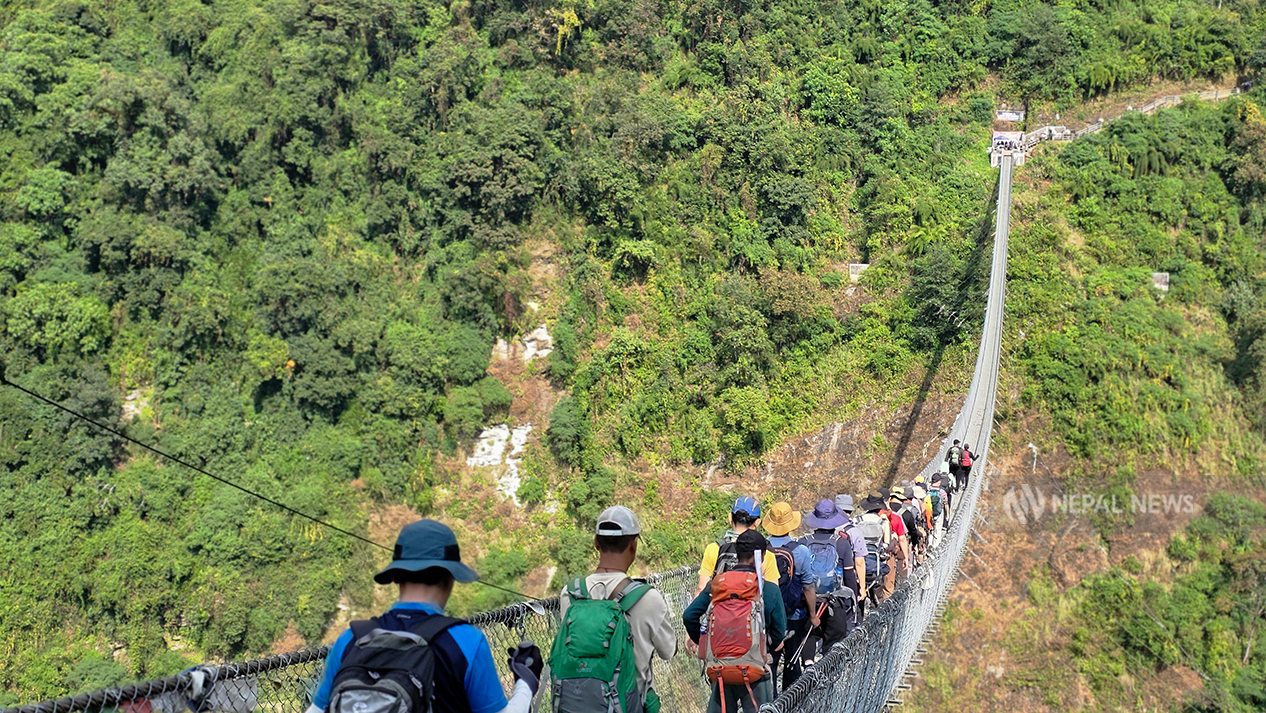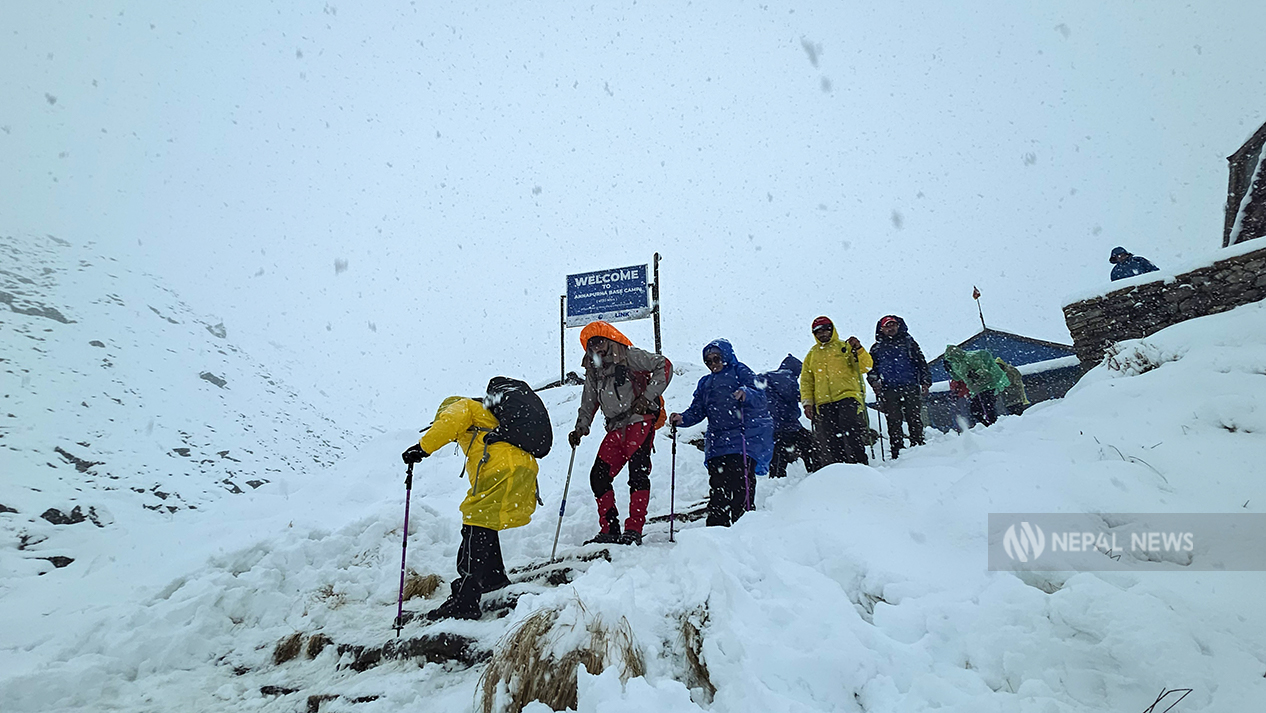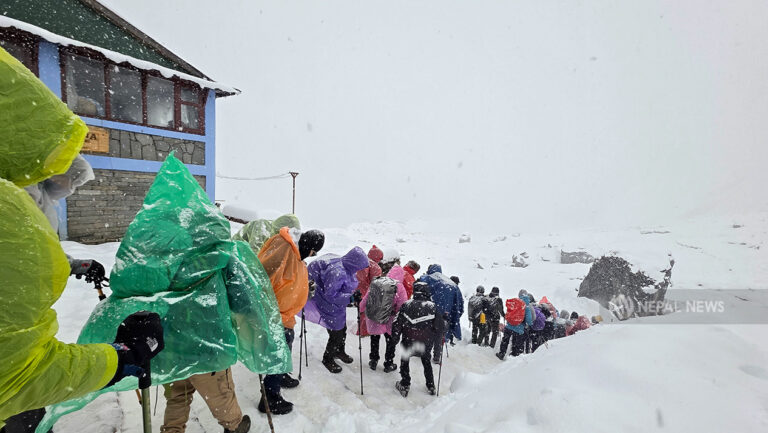
Trekkers are proceeding without essential safety data, exhibiting ignorance regarding altitude risk and route conditions

KATHMANDU: Suraj Man Shrestha of Chitwan, who went trekking to Annapurna Base Camp (ABC) in Annapurna Rural Municipality, Kaski, passed away at the age of 34. Shrestha, who was trekking alone, suffered from altitude sickness at Machhapuchhre Base Camp. According to local hotel owner Bhim Gurung, porters carried him to Deurali after he collapsed on the trail. Shrestha spent the night in a hotel there, and around 11:00 AM the next day, he asked to sit in the sun, where he was put. However, he soon became unconscious.
According to Kaski District Police Spokesperson Hari Basnet, by the time police arrived at 1:00 PM on October 25, he had already died.
On October 28, due to sudden rain and snowfall, the cold increased, causing a young woman who was also trekking to ABC to have difficulty breathing while returning from Machhapuchhre Base Camp. She became unconscious on the trail around 7:00 PM. After her panicked friend sought help from locals, Uttam Shrestha, an employee at a hotel, carried her all night to Sinuwa. “It took all night to carry her to Sinuwa. As the altitude sickness has lessened, her condition has become stable, and she has gotten into bedrest,” Uttam said.
In late October, three people died of altitude sickness in Manang, a district across the Himalayas. According to Superintendent of Police (DSP) Hari Prasad Paudel, Chief of the District Police Office, Manang, the deceased include Samba Ghale, 49, of Nuwakot; Ram Thapamagar, 44, of Tanahun; and Australian climber Chin Tark Chan, 49, who was returning from the Himlung Himal expedition. He added that on Tuesday, Indian national Pintu Mukherjee was also found dead.
On Sunday, an avalanche struck an expedition team at Yalung Ri Mountain in Gaurishankar Rural Municipality-9, Dolakha, at 10:30 AM, resulting in seven fatalities. According to the Dolakha District Police Office, out of a climbing team of 15 people, seven died, four are missing, and four are injured. The deceased include five foreign nationals and two Nepali citizens. Deputy Superintendent of Police Gyan Kumar Mahato informed that the foreign fatalities included three Americans, one Canadian, and one Italian national.
Deputy Superintendent of Police Raj Kumar Shrestha, Information Officer for the Gorkha District Police Office, reported that the bodies of two Italian individuals, Stefano Farinato, 67, and Alessandro Caputo, 37, who had been missing for five days on Pangbari Mountain in Gorkha, were found buried in the snow.

Trekkers crossing the suspension bridge in Jhinu
Similarly, a woman from the Czech Republic who was buried in a landslide in Nyaphedi, Chumnubri Rural Municipality-3, Gorkha, is still missing.
Altitude sickness, caused by a lack of oxygen at high altitudes in the Himalayan region, is considered a probable risk. However, altitude sickness is the cause of death for most of those who lost their lives prematurely here. This confirms that trekkers are either ignoring this risk or making major mistakes in preparation, treating it as insignificant before going on a trek.
According to hotel entrepreneur Bhim Gurung, Suraj Man Shrestha traveled directly from Chhomrong under Annapurna Base Camp to Machhapuchhre Base Camp. Chhomrong is at an altitude of 2,180 meters above sea level, while Machhapuchhre is at 3,700 meters. Locals believe that ascending 1,520 meters in a single day led to his serious health issues and subsequent death.
Aakash Gurung, a local hotel owner at Annapurna Base Camp, says that most Nepali people are found to do no preparation for trekking. “Trekkers are suffering because they proceed without even knowing about the route or the weather conditions,” he says, adding, “The problem of altitude sickness is also comparatively more visible in Nepalis.”
According to Ashok Tamang, the operator of Himalaya Hotel at Annapurna Base Camp, some Nepali trekkers are so careless they do not even carry water bottles. “They not only lack knowledge about the weather, destination, and route, but they also don’t know that they should carry good-grip shoes, a raincoat, and crampons if they have to walk in the snow,” he says.
Trekking guide Ramchandra Budhathoki says he informs himself and his guests about the weather conditions by checking Google and the media. According to him, it is standard practice to carry a down jacket, a hat, gloves, a thermos, sunglasses, a trekking pole, and healthy dry food for consumption on the trail when setting out for a Himalayan trek.

Bodies of two Italian climbers missing for five days being airlifted to Kathmandu via helicopter. Photo courtesy: Gorkha District Police Office
Dr. Budhathoki suggests that carrying items for primary treatment, such as paracetamol, oral rehydration solution, bandages, Band-Aids, altitude sickness tablets, and pain-relieving ointments for the feet, can make the journey easier. Hotel entrepreneur Tamang suggests that consuming ingredients found in the home kitchen, such as garlic, Sichuan pepper, cloves, cardamom, black salt, and lemon, can improve blood circulation in the cold and alleviate altitude sickness.
According to Dr. Prakash Budhathoki, spokesperson for the Ministry of Health and Population, altitude sickness typically appears after going above 2,500 meters. “If you are going between 2,500 meters and 4,000 meters, it is appropriate to ascend 300 meters per day. When going above 4,000 meters, you should not ascend more than 150 meters in height per day,” says Dr. Budhathoki.
According to Budhathoki, there is a risk of altitude sickness for people who walk quickly, land at high altitudes from flat areas, or have other health problems. When the body has a lack of oxygen, initial symptoms include increased respiration, headache, fatigue, dizziness, and vomiting. “If altitude sickness occurs, you should rest at the same spot or descend 300 meters to 1,000 meters. If symptoms do not improve, immediate medical treatment is necessary,” says Budhathoki.
He adds that if someone suffers from altitude sickness, they can call the 1115 hotline or contact other Provincial Health Emergency Operations Centers and the ministry for medical assistance.

Tourists returning from Annapurna Base Camp
Since trekkers have also been found to ignore basic weather forecasts alongside altitude risk, the National Disaster Risk Reduction and Management Authority on Kartik 10 (October 27) urged travelers to Himalayan and high-hill areas to obtain necessary weather forecast information from the Department of Hydrology and Meteorology before setting out.
The National Disaster Risk Reduction and Management Authority requested obtaining prior information and ‘alerts’ about the route, information about the risk of altitude sickness, making necessary preparations for trekking, stopping the journey and descending for treatment if altitude sickness occurs, and not trekking alone.
Last week, the Cyclone Montha, which entered Nepal from the Bay of Bengal, caused heavy rain and snowfall in the Himalayan region. The weather change caused by the cyclone affected most trekkers. Four lives were lost due to altitude sickness in two districts. Teams from the Armed Police Force (APF) and the Nepal Army were deployed to rescue trekkers stranded or facing health problems in various places.
The rescue of 11 domestic tourists who had set out on the Tilicho trek was only possible after five days. A team deployed from the APF’s Nepal Mountaineering Rescue Training School rescued them after a difficult nine-hour journey.

According to Shailendra Thapa, spokesperson for the Armed Police Force, during the Cyclone Montha period, a total of 945 trekkers, including 818 Nepali and 127 foreign tourists, were rescued from various routes in Manang, Mustang, and Myagdi. Raja Rama Basnet, spokesperson for the Nepal Army, said they rescued 1,515 tourists, including 1,312 domestic and 203 foreign visitors, from various locations in Manang and Mustang.
However, four people from a team of 16 that went trekking in the Langtang region from Bhaktapur are still missing. They were swept away by a flood that hit Bering Kholsa in Gosaikunda Rural Municipality-4, Rasuwa, on the evening of October 4, during their trek. Those swept away by the flood include an estimated 22-year-old Kisan Shrestha, 25-year-old Sanskriti Shrestha, 25-year-old Sangita Shrestha, and 23-year-old Rabi Shrestha. Sanskriti, Kisan, and Sangita are members of the same family.
Sagar Pandey, president of the Trekking Agencies’ Association of Nepal (TAAN), an umbrella organization for trekking agencies, says it is a happy development that Nepalis have recently established a tradition of going trekking during holidays like New Year, Dashain, and Tihar, but the risks are equally high. He argues that to reduce such risks, the government should create a legal provision, similar to that for foreigners, requiring Nepalis to trek only with coordination from a trekking agency.
“Foreign trekkers only trek with a guide through a trekking agency; the guide provides adequate information and necessary advice,” he adds. “If Nepalis also arrange to trek only in coordination with a trekking agency, the trip will be safer, and the economy will also become more vibrant,” Pandey says.